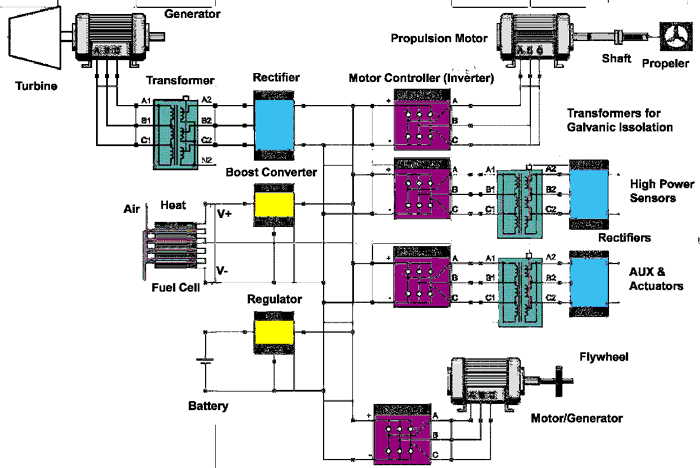Advanced Electrical Power Systems Thrust
Overview
Advanced Electrical Power Systems (AEPS) will provide the
enabling science, technology and design tools to allow electrical
power systems, electric propulsion, and auxiliary systems
to meet future mission and affordability requirements. AEPS
technologies will be applicable to all future surface ship,
aircraft carrier, and submarine platforms.
This thrust envisions an "Electrically Reconfigurable
Power System," which enables:
- A more survivable ship
- Integrated systems for ship control, C4I, engineering
plant, and damage control
- Leveraging of commercial technology
- Continuously upgraded modular architectures (hardware
and software)
- Near-zero emission of pollutants such as NOX and SOX
- Low acoustic signature
- Pulsed and high power weapon systems

The
Advanced Electrical Power System thrust applies architecture
and technology changes to increase power and energy density;
reduce size, weight, and cost (10x); and increase survivability
and reliability of electrical systems.
Systems
To implement electric drive using current technology, submarines
and smaller surface combatants would have to give up excessive
payload space, thus restricting future missions, not expanding
them. If the size and weight of power electronics can be substantially
reduced, then electric drive for smaller combatants, submarines,
and littoral warcraft will be enabled.
Other future Navy systems such as Electromagnetic Aircraft
Launch System (EMALS), Electromagnetic Aircraft Recovery System
(EARS), and advanced pulsed power weapons also will require
power electronics to control and manage shipboard energy to
meet their operating needs. Conventional power electronic
systems and design practices result in systems that are 10x
too large and heavy.
Also, highly coupled systems with limited available energy
and highly non-linear and pulsing loads create difficult stability
problems. These problems increase as power density and system
coupling increases. Advanced control architectures are needed
that will extend throughout the system to address complex
electrical equilibrium considerations, both static and dynamic.
Furthermore, Navy requirements (quiet operation, high-impact
shock, and shipboard power quality) are not satisfied by COTS
products.
Approach
Energy conversion is fundamental to future electrical power
systems. As a result, future systems will require new electrical,
electromechanical, electrochemical, electrothermal, and photoelectric
energy conversion processes and technologies. The AEPS thrust
has the following sub-thrusts that develop ship-wide energy
conversion concepts, technologies and machinery for future
electric warships:
- Electromechanics -- control, modeling/simulation, and
stability;
- Electrochemical Energy Conversion Technology -- fuel cells;
- Electrical Energy Conversion Technology -- machines, topologies,
and components (such as inverters, converters, and solid-state
protection devices);
- Electromechanical Energy Conversion Technology -- machines,
topologies, and components (such as actuators, generators,
and motors);
- Electrical Power Systems -- energy management, reconfiguration,
and Open Plug and Play architectures.
The technical strategies include:
- --
Develop modular least-replaceable units to reduce acquisition
and total ownership cost;
- -- Control
thermal, mechanical, and electrical losses to increase power
density and reduce signatures;
-
-- Develop active filtering for nonlinear and pulsing loads
to enable fight-through power for all mission-critical functions;
-
-- Develop integrated control methodologies, algorithms,
and architectures to enable dynamic reconfiguration of electrical
systems and to achieve reduced manning;
- -- Develop distributed power generation and
rapid power-transfer and energy storage for high-power electric
weapons, sensors, and countermeasures;
- -- Develop physics-based models of power
networks and simulation of total-ship power systems to enable
dynamic reconfiguration of electric, auxiliary, and damage
control systems, leading to full automation.
- Basic Research Description For:
Program Officer
Phone: 703-696-7741
E-mail: 334AE@onr.navy.mil |

